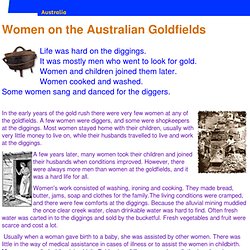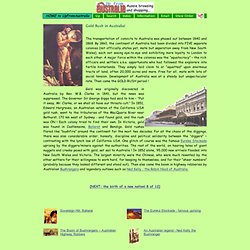

Women on the Australian Goldfields. Women on the Australian Goldfields Life was hard on the diggings.

It was mostly men who went to look for gold. Women and children joined them later. Women cooked and washed. The Australian Gold Rush. Www.patricktaylor.com | articles First published April 28th, 2006 The Australian Gold Rush - Diggers (State Library of NSW) Many people associate the Gold Rush with California or the Klondike, but the Australian gold rush remains the world's richest.

The discovery of Australian gold Isolated gold finds had been reported in New South Wales since the 1820s, but it was another thirty years before a fully-fledged gold rush would take its hold on the British penal colonies in Australia. In February 1851 Hargraves took his pan and rocking-cradle and with his guide, John Lister, set out on horseback to Lewes Pond Creek, a tributary of the Macquarie River close to Bathurst. Word spread quickly and within a few days 100 diggers were frantically tunnelling for instant wealth. Edward Hargraves did not make a fortune from gold. Australia - The Gold Rush & The Eureka Stockade for Kids - FREE Presentations in PowerPoint format, Free Interactives and Games.
Gold! Ancient Australian History. After a long trek on foot or horseback by coach or dray from Sydney or Melbourne, new miners were thankful and excited when they reached the goldfields.

On the larger fields they saw hundreds or even thousands of tents clustered around creeks or near the site of earlier discoveries. There were horses and bullocks, wagons and carts and everywhere people bustling around, digging, panning, washing gravel, moving mounds of dirt or gently rocking their cradles from side to side. New miners soon realised, however, that the goldfields were not as attractive to live in as they looked from a distance. At Bendigo, for example, up to 40,000 people lived close together in tents. They did not have enough water and their toilets were simply holes in the ground. Miners worked hard day after day and often could afford neither the time nor the money to buy good food. GoldRush. Gold Rush in Australia! The transportation of convicts to Australia was phased out between 1840 and 1868.

By 1860, the continent of Australia had been divided into FIVE separate colonies (not officially states yet, mate but seperation away from New South Wales), each not seeing eye-to-eye and exhibiting more loyalty to London to each other. A major force within the colonies was the “squatocracy” – the rich officers and settlers a.k.a. opportunists who had followed the explorers into fertile hinterlands. They simply laid claim to or “squatted” upon enormous tracts of land, often 20,000 acres and more.
Free for all, mate with lots of social tension. Development of Australia was at a steady but unspectacular rate. Gold was originally discovered in Australia by Rev. Australian gold rush timeline, Discovering gold, Gold and mining, SOSE Year 6, SA. The first major mineral discovery - gold - was a watershed (a turning point or landmark) for Australian society.

The initial stages of the gold rush were responsible for tremendous changes in the community, bringing Australia's first great waves of immigration from countries other than England and Ireland. Ambitious prospectors from Asia, Europe and America made the trek to the goldfields of Ballarat and Bendigo in Victoria, and Bathurst in New South Wales, in the hope of striking it rich. This influx of people brought many social changes, including an increase in racial tensions with the persecution of some groups, notably the Chinese. The Australian gold rush. JCF Johnson, A Game of Euchre, col. wood engraving, Australasian Sketcher Supplement [Melbourne], 25 December, 1876.

Image courtesy of the : nla.pic-an8927787. The gold rushes of the nineteenth century and the lives of those who worked the goldfields - known as '' - are etched into our national . There is no doubt that the gold rushes had a huge effect on the Australian economy and our development as a nation. It is also true to say that those heady times had a profound impact on the national psyche. The camaraderie and '' that developed between diggers on the goldfields is still integral to how we - and others - perceive ourselves as Australians. Indeed, mateship and defiance of authority have been central to the way our history has been told. Even today, nothing evokes more widespread national pride than groups of irreverent Aussie 'blokes' beating the English at cricket, or any other sport for that matter! The discovery that changed a nation Gold frenzy A nation transformed Racism.
Australian gold rushes. An Australian gold diggings circa 1855 After the California gold rush began in 1848, causing many people to leave Australia for California to look for gold there, the New South Wales government rethought its position, and sought approval from the Colonial Office in England to allow the exploitation of the mineral resources and also offered rewards for the finding of payable gold.[2] The first gold rush in Australia began in May 1851 after prospector Edward Hargraves claimed to have discovered payable gold near Bathurst, at a site he called Ophir.[3] Hargraves had been to the Californian goldfields and had learned new gold prospecting techniques such as panning and cradling.
